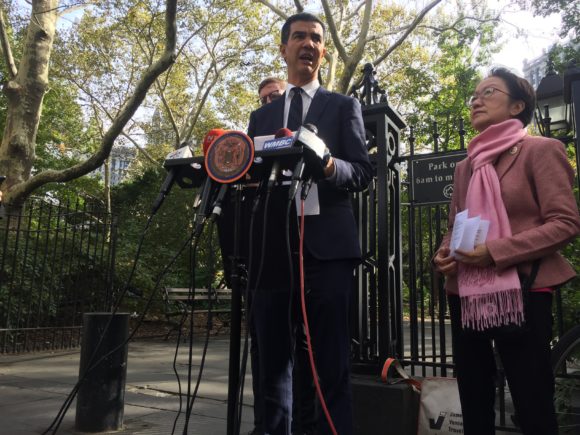Following Tuesday's mass casualty vehicular attack on the Hudson River Greenway, City Council transportation chair Ydanis Rodriguez is upping the pressure on City Hall to install physical protections around areas in NYC with the thickest concentrations of pedestrians and cyclists.
"I've been calling for months for the city to install more pedestrian bollards throughout the five boroughs," Rodriguez said at a press conference this morning. "We cannot wait for another terrorist attack when a vehicle is used as a weapon of mass destruction. The only tool that we have in our hands are pedestrian bollards."
Rodriguez filed Intro 1658 in May after Richard Rojas went on a vehicular rampage in Times Square, killing one person and injuring almost two dozen. It's likely more people would have lost their lives in that attack had there not been metal bollards lining the sidewalk.
The bill would mandate the installation of bollards around every school and pedestrian plaza, as well as "priority intersections" with high volumes of foot traffic. It quickly gained support from a majority of council members.
At a June hearing, DOT reps said the city needs more leeway to determine where to install bollards. The specific mandates in the bill would "interfere with the expertise and informed judgment of the NYPD regarding counterterrorism measures" and deny DOT the flexibility of "selecting the right designs, treatments, and features based on the context of each location."
Rodriguez said today that he trusts the city's judgment, but that NYPD and DOT can't sit on their hands and do nothing. "We as a city deserve to know there's a plan," he said.
"The mayor must make these lifesaving devices part of the standard street design toolbox that the DOT must have," Transportation Alternatives Executive Director Paul Steely White said. "Just like speed humps are now a standard part of New York City street design, so must be these lifesaving bollards."
Currently, Rodriguez said, DOT charges businesses and nonprofits who want bollards installed $400 per bollard per year. That can lead to misallocation of resources.
"Bank of America at 42nd Street and Sixth Avenue -- they have probably more than 50 bollards protecting the sidewalk," he said. "On the other side of 42nd Street and Sixth Avenue, we have the same volume of New Yorkers and tourists that walk in that area. There's no protection there."






